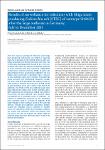Results of surveillance for infections with Shiga toxinproducing Escherichia coli (STEC) of serotype O104:H4 after the large outbreak in Germany, July to December 2011
Frank, Christina
Milde-Busch, Astrid
Werber, Dirk
After the massive outbreak of infections with Shiga toxin-producing Escherichia coli (STEC) of serotype O104:H4 in Germany in the summer of 2011, post-outbreak surveillance for further infections with this type of STEC was maintained until the end of 2011. This surveillance was based on national mandatory reporting of STEC infections and the associated complication of haemolytic uraemic syndrome (HUS), as well as on data obtained from a questionnaire. Between the outbreak’s end (5 July) and 31 December 2011, a total of 33 post-outbreak cases were recorded. Post-outbreak cases occurred with diminishing frequency towards the year’s end and resembled the outbreak cases in many respects, however the proportion of HUS among all post-outbreak cases was smaller than during the outbreak. Two thirds of the post-outbreak cases were likely infected by contact with known outbreak cases. Both laboratory and nosocomial spread was noted in this period. No post-outbreak case recalled sprout consumption as a potential source of infection. The scarcity of information conveyed by the nonculture tests routinely used in Germany to diagnose STEC made linkage of post-outbreak cases to the outbreak difficult. Though post-outbreak surveillance demonstrated the outbreak strain’s potential for lengthy chains of transmission aided by prolonged shedding, our results and continued routine surveillance until the end of 2013 do not support the notion, that the outbreak strain has been able to establish itself in the German environment.
Dateien zu dieser Publikation
Keine Lizenzangabe
Verwandte Publikationen
Anzeige der Publikationen mit ähnlichem Titel, Autor, Urheber und Thema.
-
2008-11-01ZeitschriftenartikelShiga Toxin-producing Escherichia coli Serogroups in Food and Patients, Germany. Werber, Dirk; Beutin, Lothar; Pichner, Rohtraud; Stark, Klaus; Fruth, AngelikaWe compared 61 Shiga toxin-producing Escherichia coli (STEC) serogroups from 448 food isolates with 71 STEC serogroups from 1,447 isolates from patients in Germany. Two thirds (41/61), representing 72% of food isolates, ...
-
2011-06-02ZeitschriftenartikelUpdate on the ongoing outbreak of haemolytic uraemic syndrome due to Shiga toxin-producing Escherichia coli (STEC) serotype O104, Germany, May 2011 Askar, Mona; Faber, Mirko; Frank, Christina; Bernard, Helen; Gilsdorf, Andreas; Fruth, Angelika; Prager, Rita; Höhle, Michael; Süß, Thorsten; Wadl, Maria; Krause, Gérard; Stark, Klaus; Werber, DirkSince early May 2011, a large outbreak of haemolytic uraemic syndrome (HUS) and bloody diarrhoea related to infections with Shiga toxin-producing Escherichia coli (STEC) has been observed in Germany. The outbreak is focused ...
-
2014-12-04ZeitschriftenartikelLow Rates of Antimicrobial-Resistant Enterobacteriaceae in Wildlife in Taï National Park, Côte d’Ivoire, Surrounded by Villages with High Prevalence of Multiresistant ESBL-Producing Escherichia coli in People and Domestic Animals Albrechtova, Katerina; Papousek, Ivo; Nys, Helene de; Pauly, Maude; Anoh, Etile; Mossoun, Arsene; Dolejska, Monika; Masarikova, Martina; Metzger, Sonya; Couacy-Hymann, Emmanuel; Akoua-Koffi, Chantal; Wittig, Roman M.; Klimes, Jiri; Cizek, Alois; Leendertz, Fabian; Literak, IvanAntimicrobial resistance genes can be found in all ecosystems, including those where antibiotic selective pressure has never been exerted. We investigated resistance genes in a collection of faecal samples of wildlife ...

